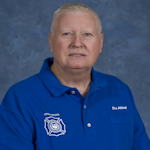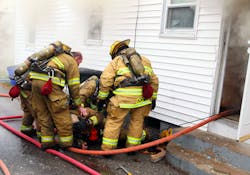“Mayday! Mayday! Mayday!”—the three words no incident commander (IC) ever wants to hear. But what do we really know about maydays? Most of us have never experienced one, which relegates us to learning about them through articles or reports on the subject.
After I made this realization, I decided to do my own investigation into fire service maydays What I found was that no one is really tracking them—why, when and how are they occurring, and what the has response been. So I decided to pursue this information on my own. Most maydays don’t get much attention unless they result in injuries or death. Therefore, there is not much information-sharing on the how, when and where they take place, or what the rescue results were. The more we know about maydays, the more we can tailor our training so that we can address the aspects of our job where firefighters are most in danger.
“Project Mayday” is born
We secured a private foundation grant to study maydays, calling our year-long endeavor “Project Mayday.” With the assistance of two individuals with PhDs in statistics and analytics—Dr. Venton Bennett and Dr. Jason Bebermeir—we assembled a three-part survey for departments wanting to report maydays. Our intent was to gather facts, not assumptions.
We obtained mayday information from departments in several different ways, and were assisted by state fire chief and firefighter associations. Both volunteer and career fire departments were surveyed, and each group’s information and results were kept separate. All the information received is confidential; we do not use department or individuals’ names. None of the information is shared without fire department permission.
Three components
The survey is divided into three components. Component 1 asks for general department information (type, size, apparatus, run figures, etc.). Component 2 deals with the actual mayday event (when, where, type and response). We also request reports, tactical worksheets, photos and audio tapes. As a result of Component 2, we’ve obtained more than 800 radio traffic tapes and 75 dashcam videos. Component 3 then asks for standard operating procedures (SOPs) and other similar guidelines used by the participants.
We will finish the project by forming a committee to make recommendations regarding the prevention of maydays and the improvement of our response to them.
The following information, for both career and volunteer departments, covers data gathered from the first nine months of the project.
Volunteer departments
Department stats
- 271 departments from 29 states reported maydays
- 216 departments completed Component 1
- 177 departments completed Component 2
- 88 departments completed Component 3
Department size
The size of the volunteer fire departments was based on information presented, roster size and activity (as determined by each department). Of the volunteer departments reporting, 31 percent had a membership of 46–55 members, and 20 percent had a membership of 36–45 members.
Time maydays took place
Most maydays in volunteer departments occurred between 0001 hrs and 0300 hrs (19 percent); others occurred between 2100 hrs and 2400 hrs (17 percent). The first unit on the scene was involved in 49 percent of maydays, and 77 percent of the time, the unit was an engine.
Types of maydays
The number one cause of maydays was medical issues, primarily heart attacks (22 percent), followed by getting lost or separated from hoselines (19 percent), and falls into the basement or stairway collapse during fires (14 percent). It should be noted that many volunteer fire departments had no SOPs dealing with radio communications, or when maydays should be called.
Types of construction
Volunteer fire department maydays most often took place in residential type structures (63 percent), followed by commercial structures (23 percent) and multi-residential/apartments (14 percent).
Note: In the final report, we will break down volunteer and combination department information. In talking with many of the volunteer fire department chiefs, we found that they did not always have the time or staffing to handle our request for information and reports. We are thankful for their time and information presented.
Career departments
Department stats
- 831 departments from 47 states reported maydays
- 719 departments completed Component 1
- 539 departments completed Component 2
- 327 departments completed Component 3
(Note: The total number of maydays is 563.)
Department size
We broke down the size of career departments into nine sections. The largest number of reported maydays comes from career departments with staffing from 51–100 personnel (22 percent), followed by career departments with staffing from 101–200 personnel (21 percent). Note: We only included personnel who were in firefighting positions.
Time maydays took place
Most maydays for reporting career departments took place between 0001 hrs and 0300 hrs (25 percent), followed by between 2100 hrs and 2400 hrs (21percent) and 0300 hrs and 0600 hrs (19 percent). With more details in the final report, it should be noted that personnel who worked 48-hour shifts or overtime had a much higher than normal mayday occurrence in the last 12 hours of their shift as compared to a 24-hour shift.
Types of maydays
Most maydays occurred when a firefighter became lost or got separated from their hoseline (25 percent). The second and third most common causes involved falls through the roof (22 percent) and falls into basements and stairway collapse (22 percent). Alarming is the number of maydays dealing with low air (13 percent).
Types of construction involved
Residential type fires accounted for 53 percent of maydays, followed by multi-family apartments (22 percent) and commercial structures (27 percent). Another issue that will be detailed in the final report is the stretching of lines of more than 250 feet into commercial structures, taking short cuts and not maintaining contact with the hoseline.
Rescue stats
Following are the most recent statistics on who performed rescues due a mayday call for both career and volunteer departments:
- Another interior crew: 39 percent
- Crew of the person who called mayday: 31 percent
- Self-rescue: 18 percent
- RIT/RIC: 11 percent
It should be noted that many actual rescues did not have the required equipment to complete the rescue. All departments must be familiar with the types of rescue that may need to be performed and the equipment required to complete those rescues.
Problems observed
Our project uncovered many important facts about maydays, the most important of which may be the issues that contribute to mayday situations. Following are items that plague both career and volunteer departments:
- No 360-degree size-ups were conducted.
- Crews waited too long to move from offensive to defensive operations.
- 36 percent of all maydays took place in vacant or abandoned buildings.
- ICs tried to handle both the firefight and the rescue, instead of giving up one or the other to another chief or company officer.
- Firefighters changed radio channels too often.
- There is too much yelling and screaming over the radio.
- Many of the mayday victims express concerns after hearing who was coming in to make the rescue (physical condition of RIC/RIT team member or general abilities).
More information to come
There’s a lot more information from the surveys than what we provided in this article. We also have information gathered from the IC and the person in charge of the rescue; observations about how to report a mayday over the radio; and the length of time it takes the IC to respond to the mayday.
I believe that once all the surveys are completed, we will have a strong, realistic representation of mayday activities and therefore will be able to provide recommendations on how to prevent such events, as well as how to respond when they do occur. Until then, stay alert—stay safe.
March Webcast: Lessons from 1,000 Mayday Events – Mar. 16
Don Abbott will share the critical lessons culled from the comprehensive analysis of more than 1,000 maydays across the country. Registration opens in late-February at Firehouse.com/webcasts.

Donald Abbott
Donald Abbott retired from the fire service after spending 20 years working in the Indianapolis area. He then spent 10 years traveling the country and presenting an interactive fire-service training diorama called Abbottville. Abbott spent eight years helping to develop and coordinate the Phoenix Fire Department’s Command Training Center. Currently, he is president of CERT (Command Emergency Response Training) and is working on the Mayday Project. In 2002, he received the ISFSI’s Innovator of the Year award, and in 2006 he received the George D. Post Instructor of the Year Award. In 2014, the IAFC’s Hazardous Materials Committee gave Abbott the John Eversole Lifetime Achievement Award.






